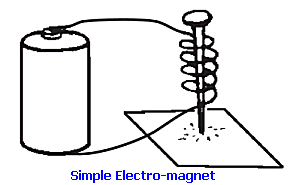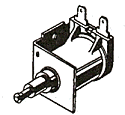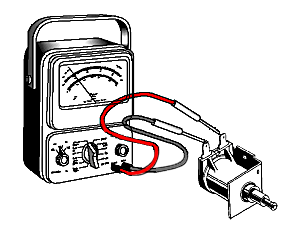|
Before we explain test procedures, we'll describe the operation of a solendiod to help you to better understand how they work.

A solenoid's main component a simple electromagnet. You may remember from your younger days building an electromagnet experiment using a nail, a coil of wire and a battery as illustrated above. When power is supplied to the coil of wire, it turns the nail into a magnet. When that power stops, the magnetism disappears. This is the basic working principles behind a solenoid but instead of picking up metal filings, the magnetism generated is used to move an armature which in turn can do work.
 In most appliance solenoids instead of having a stationary pin (nail in the illustration above) around which the coil of wire is wrapped, the coil is wrapped around a hollow tube. Through the center of this tube a metal armature is installed which is affected by the magnet field produced whenever power is supplied to the coil. This armature can be attached to levers to open or close a latch, manipulate an electrical switch (creating a relay) or move a diaphragm in a water valve. An external electrical switch can be used to activate the solenoid when required. In most appliance solenoids instead of having a stationary pin (nail in the illustration above) around which the coil of wire is wrapped, the coil is wrapped around a hollow tube. Through the center of this tube a metal armature is installed which is affected by the magnet field produced whenever power is supplied to the coil. This armature can be attached to levers to open or close a latch, manipulate an electrical switch (creating a relay) or move a diaphragm in a water valve. An external electrical switch can be used to activate the solenoid when required.
Being that this solenoid is just a single, continuous coil of wire, it can be tested for continuity to see if it is open or not.  The exact resistance doesn't usually matter as long as it has some resistance (ie. shows continuity). The symbols to the right shows how such a component may appear on an electrical schematic or wiring diagram. The exact resistance doesn't usually matter as long as it has some resistance (ie. shows continuity). The symbols to the right shows how such a component may appear on an electrical schematic or wiring diagram.

While the solenoid coil would be defective if it were electrically open (NO continuity), just having continuity doesn't necessarily mean the component is good. The solenoid's armature could be seized in place and unable to move at all or whatever that armature is connected to could be faulty as well.
| 

